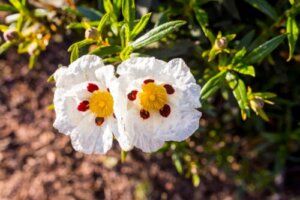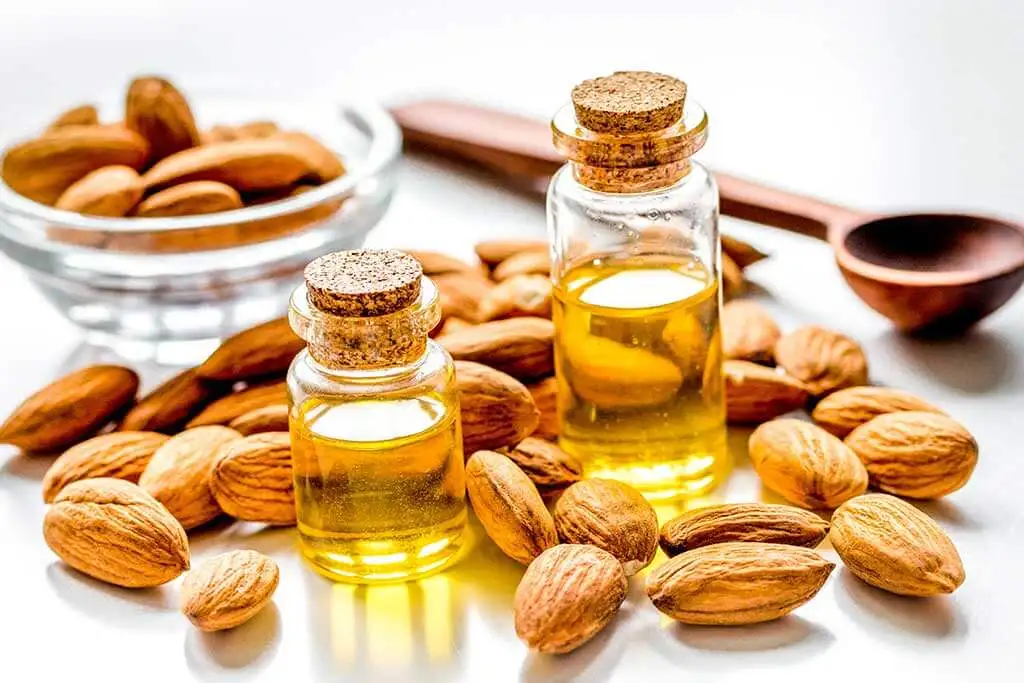Benefits and Applications of Rockrose Essential Oil


Reviewed and approved by the pharmacist Franciele Rohor de Souza
Rockrose essential oil is obtained from the plant with the scientific name Cistus ladaniferus. It belongs to the Cistaceae family and is characterized by its striking white flowers, which have small purple spots. In addition, its leaves are deep green and its stem has reddish parts.
A review shared in Plants magazine states that this shrubby species is native to the western Mediterranean region. While it’s used for ornamental purposes, it is also noted for its aromatic and pharmacological applications.
In particular, the oil obtained from the stems is valued for its cosmetic and medicinal benefits. It’s often used to promote wound healing, minimize the appearance of wrinkles, and generally protect the skin. Let’s see in detail how it works.
Benefits of rockrose essential oil
To obtain rockrose essential oil, the youngest stems of the plant are taken, especially during the summer. After this, a steam distillation process is started, which takes about three hours. The result is a product with amber notes and an herbaceous touch. It is generally used externally.
Relief of pain and inflammation
In traditional medicine, rockrose essential oil has been considered an adjuvant to soothe muscle and joint ailments. In addition, it is valued for its ability to decrease inflammatory states.
In this regard, a comparative study reported in the American Journal of Therapeutics reported that extracts of Cistus ladaniferus exhibited analgesic and anti-inflammatory potential. While more evidence is needed, it may be used topically as a remedy for mild ailments.

You may be interested in: A Remedy for Psoriasis Based on Essential Oils
Light wound healing
The application of rockrose essential oil will not remove scars overnight. Even so, it can be considered an adjunct to promote the relief of minor wounds. First of all, it acts as an antimicrobial, which reduces the risk of infections.
On the other hand, as detailed in a publication in the journal Antioxidants, its richness in antioxidant compounds – especially polyphenols – promotes skin regeneration and healing. It even provides a photoprotective effect.
Prevention of premature wrinkles
A wide variety of facial care cosmetics include rockrose essential oil among their components. The reason? Its excellent content of polyphenolic compounds exerts multiple protective and restorative functions.
These antioxidant substances mitigate the impact of oxidative stress, one of the main risk factors for premature aging. It also promotes skin elasticity, protects the skin barrier, and reduces the tired and dull appearance.
Control of minor hemorrhages
Folk medicine includes rockrose essential oil in the list of natural antihemorrhagic agents. However, there’s no conclusive evidence for these properties. Anecdotal evidence suggests that it helps stop bleeding in mild cases, such as small cuts, nosebleeds, or heavy menstrual periods.
Risks and contraindications of rockrose essential oil
Rockrose essential oil is well tolerated by most people.
It’s usually used externally, through diffusers, or combined with a carrier oil. It’s also found in some cosmetic and pharmaceutical products.
However, it should be noted that it can cause photosensitivity, especially on delicate skin. Therefore, once it’s applied, it must be protected from sunlight. Likewise, its application near the eyes or mucous membranes should be avoided because it tends to be irritating.
It’s contraindicated in pregnancy, breastfeeding, and very young children. In case of diagnosed diseases, it’s advisable to consult a doctor before use. If there’s any unfavorable reaction, its use should be discontinued immediately.
How to apply rockrose essential oil?
Some people use this product in aromatherapy or through massage. In the latter case, it should be diluted in a carrier oil, such as rose, almond, or coconut oil.
In any case, some people bet on preparing home remedies in combination with other ingredients. Let’s see.

1. Home treatment against wrinkles
A combination of vegetable oils rich in antioxidants is ideal for preventing fine lines and wrinkles. Its use can complement a nightly anti-aging routine.
Ingredients
- 8 drops of rockrose essential oil
- 6 drops of cranberry oil
- 6 drops of pomegranate oil
- 15 milliliters of rose oil
Preparation
- Combine the essential oils with the rose oil and mix well.
- Pack the product in an airtight bottle and apply a small amount to the face before going to bed.
2. Remedy to stimulate wound healing
If the objective is to promote the healing of a superficial wound, the oil can be combined with other restorative ingredients. However, its application on open or serious wounds should be avoided.
Ingredients
- 8 drops of rockrose essential oil
- 5 drops of centella asiatica oil
- 5 drops of hypericum oil
- 15 milliliters of rosehip vegetable oil
Preparation
- Mix the oils until a homogeneous product is obtained
- Apply a small amount to the desired area
- Let it absorb without rinsing
Read more: What Are Essential Oils and How and Why Do They Work?
3. Home treatment against minor bleeding
The external use of rockrose essential oil can be applied in cases of minor bleeding. This will stop the bleeding in a matter of minutes.
Ingredients
- 2 drops of rockrose essential oil
- 4 drops of vegetable oil
Preparation
- Combine the oils and, with the help of a cotton pad, apply the product to the area you wish to treat.
- Hold for a few seconds, until the bleeding stops.
What to remember about rockrose essential oil?
Due to its high content of antioxidants, anti-inflammatory compounds, and fatty acids, rockrose essential oil can be used for medicinal and cosmetic purposes. Traditionally, it’s used against pain, inflammation, and minor wounds.
It’s also considered an ally against fine wrinkles, superficial hemorrhages, and inflammation. Would you like to try it?
All cited sources were thoroughly reviewed by our team to ensure their quality, reliability, currency, and validity. The bibliography of this article was considered reliable and of academic or scientific accuracy.
- Frazão DF, Raimundo JR, Domingues JL, Quintela-Sabarís C, Gonçalves JC, Delgado F. Cistus ladanifer (Cistaceae): a natural resource in Mediterranean-type ecosystems. Planta. 2018 Feb;247(2):289-300. doi: 10.1007/s00425-017-2825-2. Epub 2017 Dec 7. PMID: 29218421.
- El Hamsas El Youbi A, El Mansouri L, Boukhira S, Daoudi A, Bousta D. In Vivo Anti-Inflammatory and Analgesic Effects of Aqueous Extract of Cistus ladanifer L. From Morocco. Am J Ther. 2016 Nov/Dec;23(6):e1554-e1559. doi: 10.1097/MJT.0000000000000419. PMID: 26934730.
- Gaweł-Bęben K, Kukula-Koch W, Hoian U, Czop M. Characterization of Cistus × incanus L. and Cistus ladanifer L. Extracts as Potential Multifunctional Antioxidant Ingredients for Skin Protecting Cosmetics. Antioxidants (Basel). 2020 Mar 1;9(3):202. doi: 10.3390/antiox9030202. PMID: 32121584; PMCID: PMC7139296.
- Andrade, D., Gil, C., Breitenfeld, L., Domingues, F., & Duarte, A. P. (2009). Bioactive extracts from Cistus ladanifer and Arbutus unedo L. In Industrial Crops and Products (Vol. 30, Issue 1, pp. 165–167). Elsevier BV. https://doi.org/10.1016/j.indcrop.2009.01.009
- Amensour, M., Sendra, E., Pérez-Alvarez, J.A. et al. Antioxidant Activity and Chemical Content of Methanol and Ethanol Extracts from Leaves of Rockrose (Cistus ladaniferus). Plant Foods Hum Nutr 65, 170–178 (2010). https://doi.org/10.1007/s11130-010-0168-2
- Rinnerthaler M, Bischof J, Streubel MK, Trost A, Richter K. Oxidative stress in aging human skin. Biomolecules. 2015 Apr 21;5(2):545-89. doi: 10.3390/biom5020545. PMID: 25906193; PMCID: PMC4496685.
- Bechlaghem, Karima & Allali, Hocine & Benmehdi, Houcine & Aissaoui, Nadia & Flamini, Guido. (2019). Chemical Analysis of the Essential Oils of Three Cistus Species Growing in North- West of Algeria. Agriculturae Conspectus Scientificus. 84. 283-293.
This text is provided for informational purposes only and does not replace consultation with a professional. If in doubt, consult your specialist.








